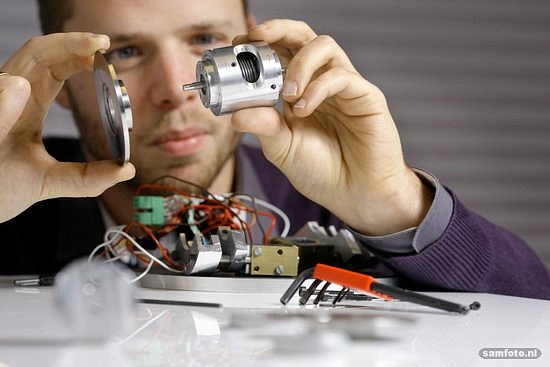Stopping a robot arm with brakes generates heat. An ingenious spring mechanism that buffers up to 80 percent of the kinetic energy makes robots more energy-efficient.
Braking converts movement into heat, which means a high energy consumption for performing repetitive tasks. Such energy inefficiencies apply to robots as well as fully automated systems.
Some systems use electrodynamic brakes, which generate electric power when braking. That way, at least a little more than half of the energy is recovered.
The spring-based buffer which Michiel Plooij MSc. (3mE) and colleagues developed, recycles up to 80 percent of the kinetic energy. On top of that, it has a simpler construction and a lower price tag than the electromechanical dynamos.
Like all great inventions, the principle of the ‘bi-directional parallel spring mechanism’ is quite simple. The cylindrical housing contains a spring in-between two of the three axes of a differential mechanism. The third axis is connected to the robot joint.
Brakes at both sides of the spring can fix the axes at any position. Turning one axis, while fixing the others, loads the spring. As long as the brakes are on, the energy remains stored in the cylinder. Releasing one of the breaks releases the energy by accelerating the robot joint into that direction.
Smart (electronic) control of the fixing brakes allows energy storage during deceleration and energy release during acceleration. The built-in spring thus not only reduces a robot’s energy consumption, it speeds up operation as well by providing extra mechanical power.
–> The invention has been patented, and it is available through the TU’s Valorisation Centre with reference number OCT-14-019.



Comments are closed.